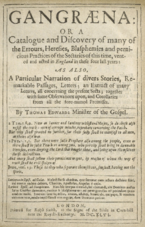
Gangraena is a book by English puritan clergyman Thomas Edwards, published in 1646. A notorious work of heresiography, it appeared the year after Ephraim Pagitt's Heresiography. These two books attempted to catalogue the fissiparous Protestant congregations of the time, in England particularly, into recognised sects or beliefs. Pagitt worked with 40 to 50 categories, Edwards went further with around three times as many, compiling a list of the practices of the Independents and more extreme radicals:
Thomas Edwards, in his Gangraena (1645), enumerated, with uncritical exaggeration, no less than sixteen sects and one hundred and seventy-six miscellaneous "errors, heresies and blasphemies," exclusive of popery and deism.
Nature of Gangraena
Gangraena is generally described as an alarmist work, deducing a collapse of national polity from the ramification of different religious creeds. Typically, the Baptist Hanserd Knollys was accused of being an Anabaptist. Heresy is foregrounded, and the analogy suggested that heresy is to the soul as witchcraft to the body. Edwards was an unsparing writer and Gangraena is described as "monumentally vituperative". The title itself refers to 2 Timothy 2:17, and "canker" in the King James translation.
It is not really a unified work, called a "complex, ramshackle text" by Nicholas Tyacke. It appeared in three volumes, with information added from correspondents, and Richard Baxter in particular was also a contributor. Scholarly opinions on it are now mixed, having in the past been somewhat dismissive of the work as paranoid and probably counter-productive in the way of providing and circulating a menu of "heretical" options. Some scholars now see it as made more coherent by its inferences from and to the diabolical element, and more readable casually for the audience of the times, than it has in the past been allowed credit.
Influence
In the work, as the first ideological identification of Levellers, Edwards summed up Levellers' views and attacked their radical political egalitarianism that showed no respect for the constitution. The prime targets in part III of his work were the men who were to be recognized as the leaders of the Leveller party.
Reception
It provoked over 30 pamphlet responses in the period 1646-7, mostly hostile. Among them were works by Jeremiah Burroughes, John Goodwin, John Lilburne, John Saltmarsh and William Walwyn.
Notes
- "Philip Schaff: History of the Christian Church, Volume VII. Modern Christianity. The German Reformation - Christian Classics Ethereal Library".
- Barry H. Howson, Erroneous and Schismatical Opinions: The Questions of Orthodoxy Regarding the Theology of Hanserd Knollys (c. 1599-1691) (2001), p. 1.
- John Marshall, John Locke, Toleration and Early Enlightenment Culture: Religious Intolerance and Arguments for Religious Toleration in Early Modern and 'early Enlightenment' Europe (2006), p. 287.
- Thomas N. Corns, A Companion to Milton (2003), p. 142.
- Nicholas Tyacke, England's Long Reformation 1500-1800 (1998), p. 241.
- William Lamont (1979), Richard Baxter and the Millennium p. 252.
- Nathan Johnstone, The Devil and Demonism in Early Modern England (2006), p. 258.
- Burns, J. H. (1991). Cambridge History of Political Thought 1450-1700. Cambridge University Press. pp. 418–419. ISBN 0521247160.
- Ann Hughes, "Popular" Presbyterianism in the 1640s and 1650s: the cases of Thomas Edwards and Thomas Hall, p. 248 in Nicholas Tyacke (editor), England's Long Reformation, 1500-1800 (1998).
- Burroughes, Jeremiah. "A Vindication of Mr Burroughes, against Mr Edwards his foule aspersions, in his spreading Gangraena, and his angry Antiapologia". Early English Books Online Text Creation Partnership. University of Michigan Library. Retrieved 19 June 2023.
- Goodwin, John. Cretensis: or A briefe answer to an ulcerous treatise, lately published by Mr Thomas Edvvards, intituled Gangræna: calculated for the meridian of such passages in the said treatise, which relate to Mr. John Goodwin; but may without any sensible error indifferently serve for the whole tract.. University of Michigan Library. Retrieved 19 June 2023.
{{cite book}}:|website=ignored (help)
Further reading
- Ann Hughes, Gangraena and the Struggle for the English Revolution, New York: Oxford University Press, 2004. ISBN 0-19-925192-4
External links
- Online text, pt. 1 and pt. 2 (Internet Archive)
- Online text, pt. 3 (Umich/eebo)